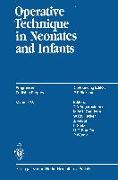- Start
- Operative Technique in Neonates and Infants
Operative Technique in Neonates and Infants
Angebote / Angebote:
In conventional partial resection of parenchymatous organs significant bleeding is one of the main problems, especially in neonates and infants. The patients rapidly lose considerable amounts of their small blood volume. Laser light leads to photo thermal effects in tissue and causes coagulation, drying up, carbonization and evaporization, depending on the temperature. The neodymium Y AG laser emits nonvisible light in the near infrared with a wavelength of l. 0611m. This wavelength implies a relatively deep penetration into the tissue. This laser system, properly a coagulation laser, achieves its cutting effect by its high power density [9]. Because of thermal radiation in all directions, both sides of the section plane are coagulated as a positive side effect. Thus, in parenchymatous organs a combination of resection and sealing of the cut vessels and ducts, up to a limited diameter, is obtained. Laser Instruments We use a neodymium-YAG laser mediLas 2 (MBB-Medizintechnik, D-8012 Ottobrunn, Federal Republic of Germany), wavelength l. 0611m, maximal power output around 110 W (Fig. 1). Normally we prefer to work without tissue contact, Fig. l. The Nd-YAG laser system mediLas 2 with maximal power output around 100 W The Neodymium Y AG Laser in Surgery of Parenchymatous Organs 25 Fig. 2. The focusing handpiece with focal distance of 50 mm 1cm Fig. 3.
Folgt in ca. 5 Arbeitstagen
